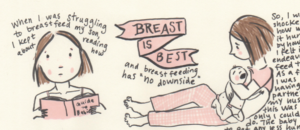Editor’s Note: While we at Everyday Feminism think that this article is brilliant in its analysis of conversations around sexual pleasure and reproductive rights, we do want to note that the piece largely normalizes sexually-oriented people. For more information on why asexuality is a valid orientation, check out this comic.

Source: FORCE: Upsetting Rape Culture via @SaraAlcid
There’s a big elephant in the room – in the conference room at most reproductive health, rights, and justice organizations, not to mention in our very own bedrooms.
As someone who occupies both of these rooms, I’m perplexed by our silence around sexual pleasure.
We advocate for increased access to abortion care and tackle abortion stigma while we’re at it. We dream up contraceptive innovations. We craft extensive policy recommendations for reproductive healthcare. But the underlying truth in all of this — that people have sex for pleasure — is something we don’t talk about.
For the most part, the same goes for our personal lives.
There are the birth control alarms, STI/STD tests, and annual exams that we’re taught to be diligent about, granted that we have access to them in the first place.
But for most people, candid conversations about pleasure – with our sexual partners, friends, or healthcare providers – are few and far between.
How Could This Be? We’re a Sex-Obsessed Culture!
We’re bombarded by hypersexualized images of women in the media, and today’s movies and TV shows are no strangers to sex scenes, so how could it be that sex is everywhere, yet silence falls on sexual pleasure?
The short answer is that there’s a big difference between sexualization and sexuality.
As Lara Riscol explains, “The real story here is how we’re such a hypersexualized, yet pleasure-starved culture. America is a Christian consumer nation bent on policing sexual expression, while selling smut and sanctimony steeped in shame.”
That is to say that we’re surrounded by and consume sexual images each day, but they come sandwiched by lessons of both shame and desire. We’re socialized to want to be what’s considered “sexy,” all the while walking the fine line of purity, as not to cross over into “slutiness.”
This is how systems of oppression work. They trap you in a place prime for policing and continual failure to correctly walk the line of acceptability. And thus, the slut shaming ensues, not to mention the subsequent enabling of rape culture.
We’ve all internalized the shame associated with sexuality and sexual pleasure so deeply that it impacts us personally and even professionally, for those of us engaged in sexual and reproductive health advocacy.
The Impact of the Pleasure Deficit
There is no doubt in my mind that the cultural and medical silence around pleasure, particularly female pleasure (or, rather, that of people with vaginas), is behind the reality that 1 in 3 women have trouble reaching orgasm during sex. (Although we do have to keep in mind that orgasming isn’t the penultimate indicator of whether or not sex is pleasurable.)
Our main source of sex education – mainstream porn and media – heavily feature heterosexual phallicentric sex, in that it usually ignores the clitoris, the sex organ that enables the majority of women and people of other genders with vaginas to achieve orgasm.
Artist Sophia Wallace shed light on this with her revolutionary mixed media art project, Cliteracy. I proudly wore a cliteracy tank to DC Pride and everywhere and anywhere thereafter because the project fulfilled my longtime cultural search for images that acknowledge and celebrate female pleasure.
Cliteracy also taught us that the clitoris was scientifically discovered in 1998. Um, hello?
This is indicative of medicine and science’s exclusion of the role of sexual pleasure in reproductive health research and clinical practice. But I would encourage us to ask if reproductive health can really exist without pleasure.
I find myself wondering if abortion stigma would exist as it does today if it weren’t for the demonization of pleasure.
Think about it: If having sex purely for pleasure weren’t stigmatized itself, would unintended pregnancy and the equally valid choices that can follow – abortion, parenting (including teen parenting) and adoption – be as politicized and stigmatized?
Would bringing pleasure into the work of reproductive health, rights, and justice help us better achieve our goals to create a world where a person’s decision-making around preventing pregnancy, ending a pregnancy, or becoming pregnant be supported — institutionally and culturally?
Creating the cultural and interpersonal space for conversations about pleasure could also help us upset rape culture and enable us to better talk about and navigate consent.
After all, when you talk to your partner(s) about what you like and dislike, what feels good and what doesn’t, it fosters the ongoing communication necessary for enthusiastic consent.
It’s not to be forgotten that the silence around pleasure has also undermined our awareness of the fact that sex isn’t pleasurable or fun for all people.
Un-nuanced sex-positivity doesn’t resonate with those healing from sexual trauma or experiencing gender dysphoria.
Our conversations about pleasure must give voice to the complex history we may have with sex and our bodies.
Doing It
So, how do we actually do this thing? Since bell hooks calls for us to create alternative feminist models of being, I’m answering!
On an interpersonal level, here are a few ways to get started on the pursuit of openness about pleasure in your own life:
1. Get Your Friends Talking
We come across representations and images of sex several times a day. It can also be a pretty common topic of conversation between friends. So the next time you come across either of these situations, consider bringing the topic of pleasure into the mix.
Ask something like “Have you ever talked to one of your sexual partners not just about pregnancy prevention and STI/STD testing, but about how to make sure sex is pleasurable for both of you?”
Or try “Why is it that TV shows often show straight couples discussing whether or not they’re ready to have sex, or them fumbling over a condom, but never discussing what each of them can do to make sex pleasurable?”
This can get the conversation started with people you trust and enable you to learn from each other’s trials and tribulations with sex and pleasure.
2. Make It Part of ‘The Talk’
Whether you’re about to have sex for the first time ever, sex for the first time with a person you’re in a monogamous relationship with, or sex for the first time with a person you just met that night, some variation on the “What protection are we using? What is each of us comfortable doing?” talk will occur, and hopefully continue to throughout sex and your relationship, however long or short.
Bring up pleasure in your conversations about safety and consent.
It may be awkward the first time, but something like “You should know that I love it when you do __________” will be appreciated by your partner and probably open the door to further sharing of what works, what doesn’t, and what you can both be doing to make sex more pleasurable and enjoyable for each other.
3. Check in With Yourself
Make a habit of checking in with yourself during and after sex, or really anything you do in life, about how you’re enjoying it, what could make it better, and what each person could do next time to make the experience more pleasurable.
Since none of us have been taught to deliberately do this, chances are you only check in with yourself about pleasure when it’s glaringly obvious that you didn’t enjoy something.
So make an effort to celebrate the fun and pleasurable, and be willing to admit to yourself if the pleasure piece is lacking.
***
What are some other things you’d be willing to try to bring pleasure to the forefront of your reproductive and sexual health?
[do_widget id=”text-101″]
Sara Alcid is a Contributing Writer for Everyday Feminism and is a young feminist living and working in Washington, DC as a reproductive health and justice advocate. Sara loves thinking, reading and writing about the socially and personally transformative power of feminism, queer issues, and women’s health. Follow her on Twitter @SaraAlcid. Read her articles here and book her for speaking engagements here.
Search our 3000+ articles!
Read our articles about:
Our online racial justice training
Used by hundreds of universities, non-profits, and businesses.
Click to learn more




















